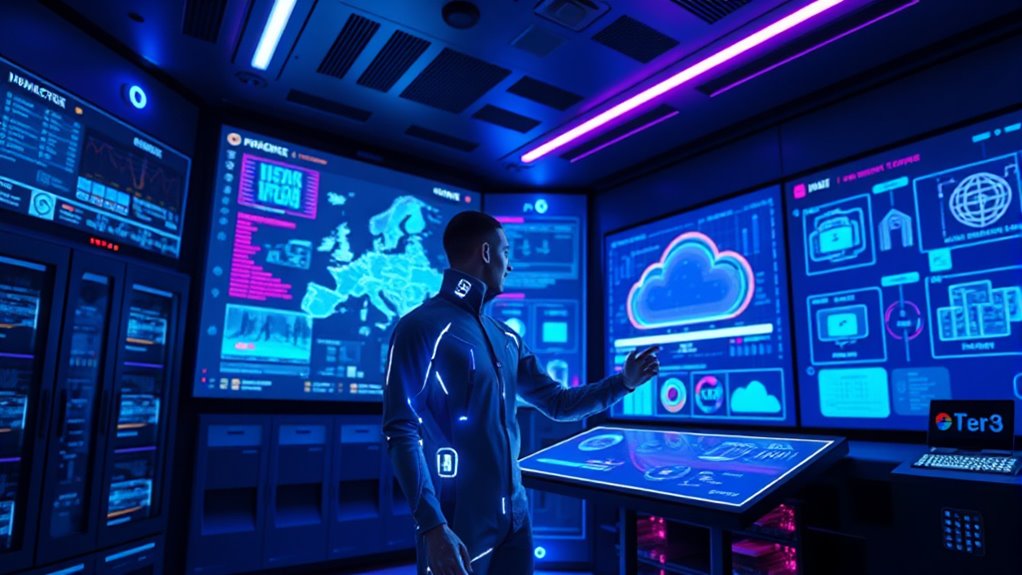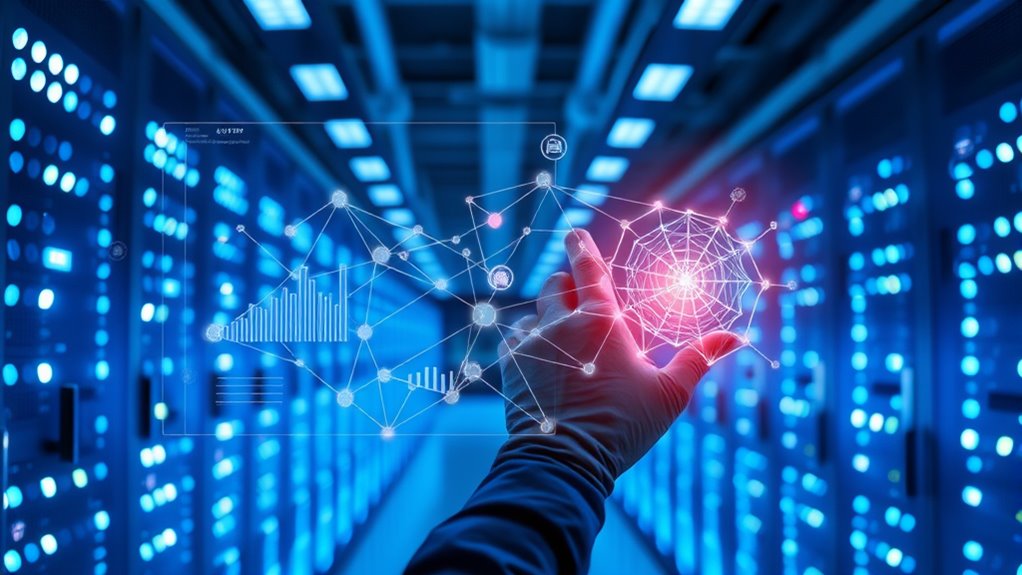AI-driven threat detection and response in cloud environments help you stay ahead of cyber dangers by providing real-time monitoring and automated actions. It uses machine learning to identify anomalies and malicious activities that traditional tools might miss. These advanced systems combine threat feeds, logs, and alerts to create a thorough security outlook. They adapt to new threats over time, reducing manual effort and improving defenses. If you keep exploring, you’ll discover how these technologies enhance your cloud security even further.
Key Takeaways
- AI leverages machine learning and real-time analytics to identify anomalies and emerging threats in cloud environments.
- Automated responses enable swift containment of threats, minimizing damage and reducing response times.
- Data correlation and threat intelligence integration provide a comprehensive view of security threats and attack patterns.
- Continuous model learning ensures adaptive security measures that evolve with emerging cyber threats.
- AI-driven systems enhance traditional security by proactively detecting sophisticated attacks beyond signature-based methods.

As cloud environments become increasingly complex and essential to business operations, traditional security measures often fall short in detecting and responding to threats swiftly. You need advanced tools that can keep pace with the dynamic nature of cloud infrastructure. AI-driven threat detection and response systems offer a solution by leveraging machine learning algorithms and real-time analytics to identify anomalies and malicious activities with remarkable accuracy. Instead of relying solely on predefined rules or signatures, these systems learn from vast amounts of data, enabling you to detect emerging threats that traditional methods might miss.
When you deploy AI in your cloud security, you’re empowering your defenses to become proactive rather than reactive. AI continuously monitors network traffic, user behavior, and system logs, flagging deviations that could indicate a breach or malicious intent. For example, if a user suddenly accesses sensitive data at unusual hours or from an unfamiliar device, the AI system recognizes this anomaly based on learned patterns and immediately raises an alert. This swift detection means you can intervene before the attacker gains significant access or causes damage. The speed of AI-driven responses helps reduce the window of opportunity for cybercriminals, minimizing potential impacts.
Moreover, AI’s ability to correlate data from multiple sources enhances your overall security posture. It can integrate threat intelligence feeds, logs, and alerts to provide a thorough view of your environment. This synthesis allows you to identify sophisticated attack vectors that might slip past traditional security tools. When a threat is detected, AI-driven systems can automatically initiate responses, such as isolating affected systems, revoking compromised credentials, or deploying patches—all without human intervention. This automation accelerates your response time, ensuring threats are contained before they escalate.
You also benefit from AI’s capacity to adapt to new threats. As cybercriminals evolve their tactics, AI models learn and update continuously, staying ahead of emerging attack methods. This adaptability reduces your reliance on manual rule updates and helps maintain a resilient security posture. Additionally, AI-driven threat detection provides detailed insights and reports, helping you understand attack patterns and vulnerabilities, so you can strengthen your defenses proactively.
Furthermore, understanding the role of contrast ratio in image quality is vital for visual clarity, but in cybersecurity, the ability of AI to differentiate between legitimate activity and threats—similar to contrast in images—enhances detection accuracy. In essence, integrating AI into your cloud security strategy transforms your ability to detect and respond to threats in real time. It shifts your approach from guesswork and manual responses to intelligent, automated defenses that evolve with the threat landscape. As cyber threats grow more sophisticated, leveraging AI ensures your cloud environment remains protected, resilient, and ready to counteract attacks swiftly and effectively.
Frequently Asked Questions
How Does AI Handle Zero-Day Vulnerabilities in Cloud Environments?
AI handles zero-day vulnerabilities by continuously analyzing network behavior, identifying anomalies that could indicate new threats, even without prior signatures. It learns from patterns and adapts quickly, helping you spot unusual activity early. While AI isn’t foolproof, it provides real-time detection and automated responses that can contain damage until patches or fixes are developed. This proactive approach helps you stay ahead of emerging threats in your cloud environment.
What Are the Privacy Implications of AI Surveillance in Cloud Security?
You might think AI surveillance in cloud security keeps your data safe, but it often comes with a privacy catch. While it monitors threats, it can also collect and analyze your personal info without clear consent. Ironically, in trying to protect you, it risks exposing or misusing your data. So, you must stay vigilant about how much surveillance is too much, even when it promises security.
How Does AI Detect Insider Threats in Cloud Platforms?
You can detect insider threats in cloud platforms by AI analyzing user behavior patterns, access logs, and activity anomalies. It continuously monitors for unusual login times, data transfers, or permission changes, flagging suspicious actions for review. When AI spots irregularities, it alerts you immediately, enabling swift response. This proactive approach helps prevent data breaches, ensuring your cloud environment stays secure from internal threats.
What Are the Costs Associated With Implementing Ai-Driven Security Solutions?
Implementing AI-driven security solutions is like planting a vigilant garden guard; the costs include initial setup, ongoing maintenance, and training your team. You’ll face expenses for advanced tools, cloud resources, and regular updates to keep the guard sharp. While the investment might seem high, it’s like watering your garden to guarantee your digital landscape remains healthy and protected, guarding against unseen threats that could otherwise cause costly damage.
How Is AI Kept Up-To-Date With Evolving Cyber Threats?
You keep AI up-to-date with evolving cyber threats by continuously feeding it new data from threat intelligence feeds, security reports, and real-time attack patterns. Regularly updating algorithms and models ensures the system adapts quickly to emerging tactics. Additionally, you should implement machine learning techniques that enable AI to learn from new threats automatically, maintaining accuracy and effectiveness without manual intervention. This ongoing process is essential for robust security.
Conclusion
As you leverage AI-driven threat detection, you markedly enhance your cloud security. With AI systems detecting threats 60% faster than traditional methods, you reduce potential damages and downtime. Embracing these advanced tools means you’re proactively safeguarding your data and infrastructure. The faster you adopt AI solutions, the better you’ll stay ahead of cybercriminals, ensuring your cloud environment remains resilient and secure in an ever-evolving threat landscape.









